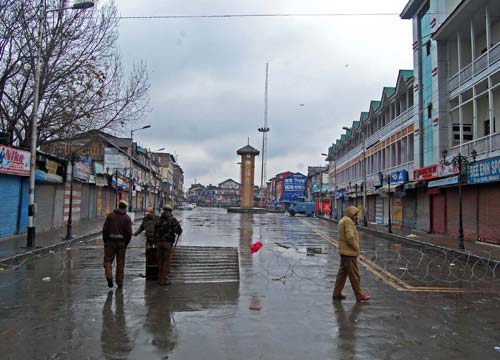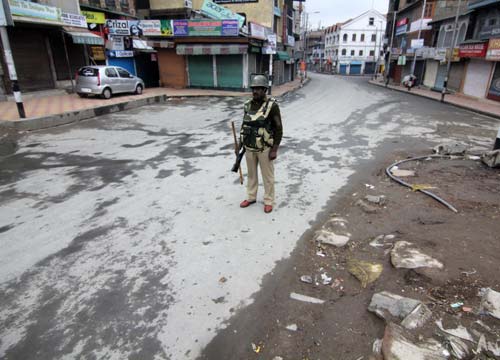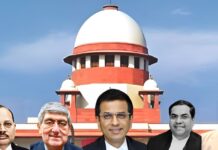As a deceptive normalcy returns to Kashmir amid separatist-sponsored strikes and government imposed curfews, a lot of reportage is emerging on Afzal Guru case suggesting that vital clues to the 2001 Parliament Attack were ignored, Saima Bhat reports.

After Muhammad Afzal Guru was sent to gallows, various Delhi based and international media outlets were flooded with reports that ‘proper investigation’ and ‘proper trial’ was not followed in the Parliament Attack convict’s case. Back in Kashmir, the much vocal independent lawmaker, Engineer Rasheed appealed to the state chief minister Omar Abdullah that his government should probe the role of state officials in ‘setting up’ Afzal.
“Omar Abdullah said that nothing was in his hands when Guru was hanged, but this is in his hands”, said Rasheed while addressing a news conference after his release. He was the only lawmaker who was arrested on February 9 when Afzal was executed. He had moved a resolution seeking clemency for Afzal in the state legislature which was supposed to be taken up on September 28, 2011, but all parties remained busy with squabbling in the house, creating a situation that entire business of the day was suspended.
On the basis of a letter written by Afzal to his Supreme Court lawyer, Sushil Kumar, some names of state police force surfaced whom Afzal blamed for “torturing and manifesting him in a false case.”
In the 2004 letter, Afzal had told his lawyer that “DSP Davinder Singh”, then with J&K Police’s Special Operations Group at Humhama, had asked him to “take Mohammad”, a co-accused in the Parliament attack case, “to Delhi, rent a flat for his stay and purchase a car for him”. Afzal had also alleged that Singh and Shanty Singh had “tortured him at the Humhama STF camp.”
It was Altaf Hussain, a senior police officer’s brother-in-law who had “brokered” his release by organizing a meeting between his (Afzal’s) family and Davinder, and that the DSP had later asked him to take a man to Delhi.
Delhi based newspaper Indian Express reported that, “DSP Davinder Singh is currently in Traffic police, Shanty Singh is in jail after Crime Branch investigation in 2003 found him involved in torturing a civilian Mohammad Ayoub Dar of Sholipora, Pakharpore, to death in police custody and then firing at his body, dubbing him as a militant killed in an encounter.” When contacted by Kashmir Life, DSP Davinder Singh first made an excuse that he is driving and will talk later. When contacted again, his phone remained out of reach.
Shanty Singh is in jail under the sections of custodial killing (FIR 77/2003) and corruption charges (FIR 24/ 2006). Some reports have claimed that Tariq who met Afzal in STF camp was dead but some informed sources told Kashmir Life that he is still alive.
Afzal was arrested after the attack along with three other people; his cousin Shaukat Hussain Guru, Shaukat’s wife, Afsan Guru, and SAR Geelani, a teacher of Arabic at Delhi University, for ‘conspiring’ the Parliament Attack. Afzal and Shaukat were convicted while Afsan and Geelani were acquitted. Shaukat was later released after 10 years of rigorous imprisonment.
India’s celebrated author and activist, Arundhati Roy put forward 13 questions in her book on the Parliament Attack, which questions the system of investigation followed in the case of Afzal. In the first question, she raises finger on the then prime minister and police, who kept on saying “months before that Parliament could be attacked. On December 12, 2001, at an informal meeting, the Prime Minister Atal Bihari Vajpayee warned of an imminent attack on Parliament and on December 13, Parliament was attacked. Given that there was an ‘improved security drill’, how did a car bomb packed with explosives enter the parliament complex?”

After the attack, more than half a million soldiers were mobilized under Operation Parakarm on Indo-Pak border under Operation Parakram, which remained there for nearly 11 months in which around “789 soldiers were killed, some died while laying the landmines and many more were killed during the actual occasional gun-battles.”
While commenting on the investigations, Roy questions that “in a criminal investigation, it is vital for the police to show how the evidence gathered at the scene of the attack led them to the accused. How did the police reach Mohammad Afzal? The Special Cell says SAR Geelani led them to Afzal. But the message to look out for Afzal was actually flashed to the Srinagar Police before Geelani was arrested. So how did the Special Cell connect Afzal to the 13 December attack?” She also questions that “If DSP Davinder told Afzal to take a man Mohammad to Delhi then the same person got killed in parliament attack. Did J&K police send the attacker to Delhi?”
It is not only Roy who didn’t get her answers but the various ‘loopholes’ which have now surfaced require a thorough investigation as there are many inter-links in the parliament attack which put fingers towards the Delhi police’s Special cell and J&K police.
As per a report published in Open magazine, the entire investigation was based on confessions made in police custody which was later called ‘unreliable’ by the Supreme Court. “At the time of the attack, a fact the court upheld, Afzal did not belong to any banned terror outfit, having quit militancy and given himself up to the Border Security Force in 1993.” The magazine, while quoting a senior cop (in 2005), describes it as “the biggest fake encounter in India.”
Khurram Parvez, the Coordinator of Jammu and Kashmir Coalition of Civil Society, says, “At least 840 Indian soldiers were killed (in Parakram operation) without even fighting a war on landmines. If it is fake encounter as they say, then it is not a normal crime.” He says it needs to be investigated as it is not limited to Afzal or the 17 people only who got killed that day but it raises the question on the deaths of hundreds of Indian soldiers who got killed after that and were “used as cannon fodder for a mysterious operation.”
“The state government should set up a commission for the threads which are emerging now and are leading us to the fact that something suspicious and more dangerous was there. Those enemies of India and Pakistan should be exposed and should be taken to task.”
The Open magazine has also written about the parts of Afzal’s letter in which he informed his lawyer about the “STF”, and the phone records. It also tells about the link of Parliament Attack and Thane police station, which had arrested four Lashkar-e-Toiba men from Mumbra on November 23, 2000, one year before the attack.
“When the names of the five killed assailants (in Parliament Attack) were made public, the Thane Police sought a clarification. SM Shangari, then Police Commissioner of Thane, as one of them had the same name as one whom they had arrested from Mumbra. Shangari spotted similarities between the blueprints, maps, arms and ammunition seized from the four arrested in Thane and the material recovered from the five bodies in New Delhi. The commissioner wanted to check if the killed militant was the same man they had arrested”, the magazine report said.
Sangari had then informed that the four militants arrested by the Thane Police had been handed over to the J&K Police on December 8, 2000, which was done on the orders of the Thane District Court via a transit remand, since they were ‘wanted’ by the J&K Police for other cases. But K Rajendra, then inspector general of the J&K Police, dismissed Shangari’s enquiries calling it a case of ‘mistaken identity’ and arguing that Hamza is a common Muslim name.
But the four LeT men sent on remand to J&K police were ‘never’ sent back to Thane police and instead they (JK Police) informed that the one, found similar to one killed in Parliament Attack, was shot dead by the police while allegedly attempting to escape from custody.
To further investigate the case, the Open magazine correspondent, Mihir Shrivasta writes, “I tried to do what Shangari had wanted. I procured all their details available, including pictures, and concluded that one of the four arrested in Thane was among those shot that day: the hairline and nose matched, as did a cut over the left eyebrow. I got a forensic expert at AIIMS to examine these pictures. He asked for more details. We compared physical attributes. While this person’s height mentioned in the post-mortem report did not match what was recorded by the Thane Police, the difference was just an inch.”
But if the one arrested in Mumbai was sent to J&K police, then how was the same person killed in Parliament Attack?
The three ‘masterminds’ of the operation – Ghazi Baba, Masood Azhar and Tariq, operatives of Lashkar-e-Toiba (LeT) and Jaish-e- Mohammad (JeM) outfits were never arrested. Of these, “Ghazi Baba was shot by security forces in 2004, and his body was identified by Afzal Guru in his capacity as a former militant.”
J&K lawmaker Rashid’s call for a probe has been supported by the opposition PDP as well as a member of the ruling National Conference. But he himself is sure that government won’t do anything. “I am going to stress on the probe in the assembly as well but the present government has always been sheltering the ones who are in uniform. So I don’t have any expectations from them.”
While commenting on the situation how Afzal was “set up”, the Peoples Democratic Party’s spokesperson, Nayeem Akhter says that it is for the people to see what kind of atmosphere National conference had created in the state and from what hell people have come out. He further says that he is not expecting anything from the ruling government. “The government that collaborated in Afzal’s execution, how can we expect from them that they will probe into the matter that how Afzal was used by state agencies. They are taking us back to the same dark era and they are living only by police.”















